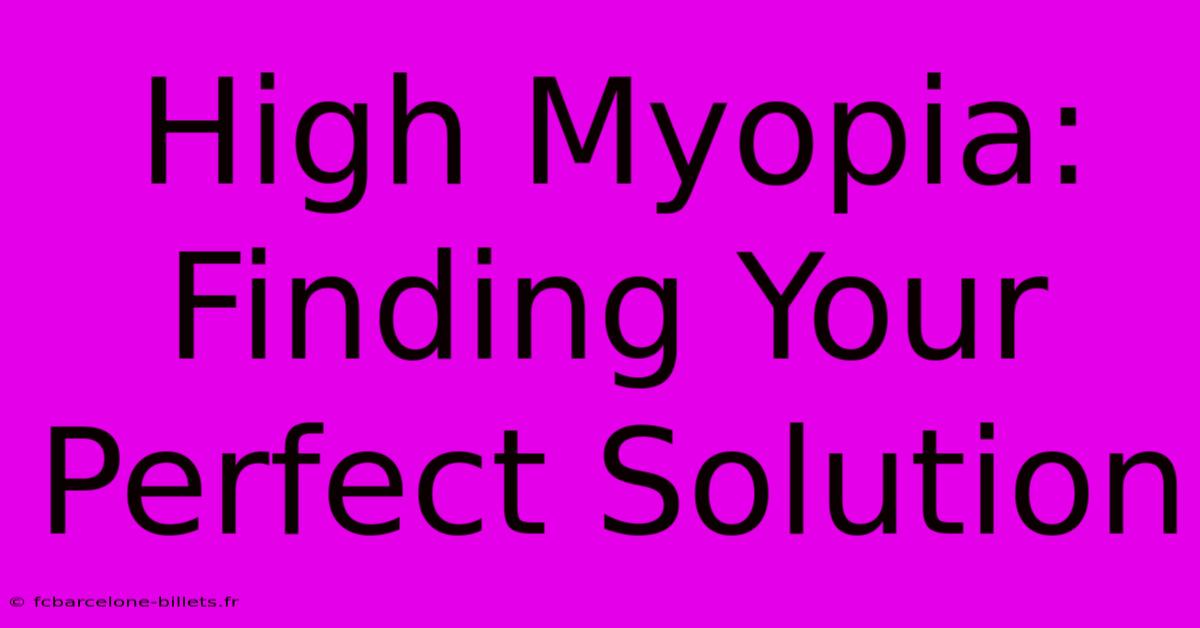High Myopia: Finding Your Perfect Solution

Table of Contents
High Myopia: Finding Your Perfect Solution
High myopia, or severe nearsightedness, significantly impacts daily life. If you're struggling with blurry distance vision and the limitations it brings, you're not alone. This comprehensive guide explores the various options available to help you achieve clearer vision and improve your quality of life. We'll delve into treatment options, lifestyle adjustments, and the importance of regular eye exams.
Understanding High Myopia
High myopia is defined as a refractive error where your eyeball is longer than normal, causing light to focus in front of the retina instead of directly on it. This results in blurred distance vision. It's often diagnosed when your prescription reaches -6.00 diopters or higher. While genetics play a significant role, environmental factors like prolonged near-work and insufficient time outdoors are also believed to contribute.
Risks Associated with High Myopia
High myopia increases your risk of developing serious eye conditions later in life, including:
- Retinal detachment: A separation of the retina from the underlying tissue, potentially leading to vision loss.
- Glaucoma: Increased pressure within the eye, damaging the optic nerve.
- Cataracts: Clouding of the eye's lens, impairing vision.
- Macular degeneration: Damage to the macula, the central part of the retina responsible for sharp, central vision.
Treatment Options for High Myopia
Several options exist to manage and treat high myopia. The best approach will depend on your individual needs and preferences, as well as the severity of your condition. Always consult with your ophthalmologist or optometrist to determine the most suitable course of action.
1. Corrective Lenses
Eyeglasses and contact lenses remain the most common and readily accessible methods for correcting high myopia. High-index lenses are often recommended to reduce the thickness and weight of eyeglasses. While contact lenses offer sharper peripheral vision, they require careful hygiene practices.
2. Refractive Surgery
For those seeking a permanent solution, refractive surgery offers various possibilities:
- LASIK (Laser-Assisted In Situ Keratomileusis): A common procedure that reshapes the cornea to improve focus. However, it may not be suitable for everyone with high myopia.
- PRK (Photorefractive Keratectomy): An alternative to LASIK, it removes a layer of the cornea to correct the refractive error. Recovery time is typically longer than with LASIK.
- Implantable Collamer Lenses (ICL): These lenses are surgically implanted within the eye to correct high myopia. They are a good option for those unsuitable for LASIK or PRK.
Important Note: Refractive surgeries carry potential risks and complications. It's crucial to thoroughly discuss these risks with your surgeon before proceeding.
3. Lifestyle Modifications
Beyond medical interventions, lifestyle changes can positively impact the progression of high myopia, especially in younger individuals:
- Spend time outdoors: Studies show that increased time spent outdoors may slow myopia progression. Aim for at least two hours of daily outdoor activity.
- Take frequent breaks from near work: The 20-20-20 rule suggests taking a 20-second break to look at something 20 feet away every 20 minutes of near work.
- Maintain a healthy diet: A balanced diet rich in antioxidants and vitamins may contribute to overall eye health.
Regular Eye Exams: Crucial for High Myopia Management
Regular comprehensive eye exams are vital for monitoring the progression of high myopia and detecting any potential complications early on. Your eye doctor will assess your vision, check for any retinal abnormalities, and advise on the best course of management. The frequency of these exams should be determined based on your individual needs and risk factors.
Finding the Right Solution for You
Choosing the right solution for managing high myopia is a personal journey. It requires open communication with your eye care professional, a thorough understanding of your options, and a realistic assessment of your lifestyle and expectations. By actively participating in your eye health care and making informed choices, you can significantly improve your vision and quality of life. Remember, proactive management is key to mitigating the long-term risks associated with high myopia.

Thank you for visiting our website wich cover about High Myopia: Finding Your Perfect Solution. We hope the information provided has been useful to you. Feel free to contact us if you have any questions or need further assistance. See you next time and dont miss to bookmark.
Featured Posts
-
Your Local Florist Fresh Flowers Barcelona
Apr 08, 2025
-
The Best Barcelona Home Kit 19 20
Apr 08, 2025
-
The Most Wanted Backpack Nike Barcelona
Apr 08, 2025
-
Barcelona Falls Ny Beat The Blues
Apr 08, 2025
-
Experience Barcelona Like A Local Stay In A Dorm
Apr 08, 2025
